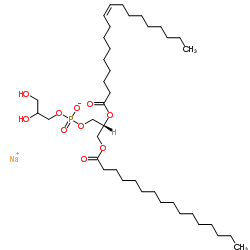1-palmitoyl-2-oleoyl-sn-glycero-3-phospho-(1′-rac-glycerol) (sodium salt)

1-palmitoyl-2-oleoyl-sn-glycero-3-phospho-(1′-rac-glycerol) (sodium salt) structure
|
Common Name | 1-palmitoyl-2-oleoyl-sn-glycero-3-phospho-(1′-rac-glycerol) (sodium salt) | ||
|---|---|---|---|---|
| CAS Number | 268550-95-4 | Molecular Weight | 770.989 | |
| Density | N/A | Boiling Point | N/A | |
| Molecular Formula | C40H76NaO10P | Melting Point | N/A | |
| MSDS | USA | Flash Point | N/A | |
|
Binding properties of antimicrobial agents to lipid membranes using surface plasmon resonance.
Biol. Pharm. Bull. 37(8) , 1383-9, (2014) In the present study, we examined the interaction of antimicrobial agents with four model lipid membranes that mimicked mammalian cell membranes and Gram-positive and -negative bacterial membranes and analyzed the binding kinetics using our surface plasmon re... |
|
|
Characterizing the structure of lipodisq nanoparticles for membrane protein spectroscopic studies.
Biochim. Biophys. Acta 1848(1 Pt B) , 329-33, (2015) Membrane protein spectroscopic studies are challenging due to the difficulty introduced in preparing homogenous and functional hydrophobic proteins incorporated into a lipid bilayer system. Traditional membrane mimics such as micelles or liposomes have proved... |
|
|
Detergent-type membrane fragmentation by MSI-78, MSI-367, MSI-594, and MSI-843 antimicrobial peptides and inhibition by cholesterol: a solid-state nuclear magnetic resonance study.
Biochemistry 54(10) , 1897-907, (2015) Multidrug resistance against the existing antibiotics is becoming a global threat, and any potential drug that can be designed using cationic antimicrobial peptides (AMP) could be an alternate solution to alleviate this existing problem. The mechanism of acti... |
|
|
Cell-penetrating antimicrobial peptides - prospectives for targeting intracellular infections.
Pharm. Res. 32(5) , 1546-56, (2015) To investigate the suitability of three antimicrobial peptides (AMPs) as cell-penetrating antimicrobial peptides.Cellular uptake of three AMPs (PK-12-KKP, SA-3 and TPk) and a cell-penetrating peptide (penetratin), all 5(6)-carboxytetramethylrhodamine-labeled,... |
|
|
Mechanistic insights into the lipid interaction of an ancient saposin-like protein.
Biochemistry 54(9) , 1778-86, (2015) The members of the expanding family of saposin-like proteins (SAPLIPs) have various biological functions in plants, animals, and humans. In addition to a similar protein backbone, these proteins have in common the fact that they interact with lipid membranes.... |
|
|
Spectroscopic investigations of the binding mechanisms between antimicrobial peptides and membrane models of Pseudomonas aeruginosa and Klebsiella pneumoniae.
Bioorg. Med. Chem. 22(15) , 4210-22, (2014) CD spectroscopy was used to investigate the interactions of a series of synthetic AMPs with LPS isolated from Pseudomonas aeruginosa and Klebsiella pneumoniae, as well as with various phospholipids to better approximate the chemical composition of the membran... |
|
|
Lysophospholipid-containing membranes modulate the fibril formation of the repeat domain of a human functional amyloid, pmel17.
J. Mol. Biol. 426(24) , 4074-86, (2014) Pmel17 is an important protein for pigmentation in human skin and eyes. Proteolytic fragments from Pmel17 form fibrils upon which melanin is deposited in melanosomes. The repeat domain (RPT) derived from Pmel17 only forms fibrils under acidic melanosomal cond... |
|
|
Application of Asymmetric Flow Field-Flow Fractionation hyphenations for liposome-antimicrobial peptide interaction.
J. Chromatogr. A. 1422 , 260-9, (2015) Asymmetric Flow Field-Flow Fractionation (AF4) combined with multidetector analysis form a promising technique in the field of nanoparticle characterization. This system is able to measure the dimensions and physicochemical properties of nanoparticles with un... |
|
|
Vesicle Leakage Reflects the Target Selectivity of Antimicrobial Lipopeptides from Bacillus subtilis.
Biophys. J. 109 , 2079-89, (2015) Cyclic lipopeptides act against a variety of plant pathogens and are thus highly efficient crop-protection agents. Some pesticides contain Bacillus subtilis strains that produce lipopeptide families, such as surfactins (SF), iturins (IT), and fengycins (FE). ... |
|
|
Surface behavior of peptides from E1 GBV-C protein: Interaction with anionic model membranes and importance in HIV-1 FP inhibition.
Biochim. Biophys. Acta 1848(2) , 392-407, (2014) The interaction between a peptide sequence from GB virus C E1 protein (E1P8) and its structural analogs (E1P8-12), (E1P8-13), and (E1P8-21) with anionic lipid membranes (POPG vesicles and POPG, DPPG or DPPC/DPPG (2:1) monolayers) and their association with HI... |